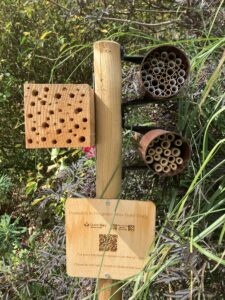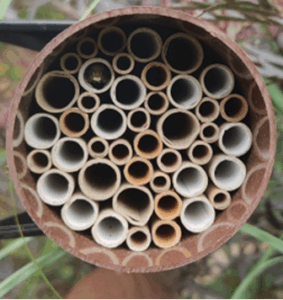The gardens at the Charterhouse have long been a quiet refuge for both people and pollinators. From the English lavender to the summer flowering herbs, these green spaces support a wide variety of wildlife. This spring, a new feature joined the garden: a solitary bee hotel.
Installed near the edge of one of the flower beds, the structure is part of a research collaboration between Queen Mary University of London and Pollinating London Together. The project explores how garden design, floral diversity, and microhabitats influence the nesting preferences of solitary bee species often overlooked, yet vital to healthy urban ecosystems.
Why solitary bees?
Unlike honeybees or bumblebees, which live in colonies, solitary bees nest alone. Each female builds her own nest often in hollow stems, soil, or wood and provisions it with pollen and nectar for her offspring. The males don’t take part in rearing young; their role is simply to mate and then wait for the next generation to emerge [2].
Despite their modest size and solitary habits, these bees are exceptional pollinators. Many solitary species are more efficient on a per-visit basis than honeybees. There are around 250 species of solitary bees in the UK, making up roughly 90% of the country’s bee population [1]. Yet their habitats are increasingly under threat from urbanisation [3].
Providing safe nesting spaces such as bee hotels is one practical way to support these important pollinators.
About the bee hotel

The bee hotel at Charterhouse situation at the edge of the flowerbed in Preacher’s Court
The Charterhouse bee hotel is one of ten being monitored across London. It was chosen as a research site due to its unique blend of historic planting, varied architecture, and contemporary horticultural management. The goal of the project is to better understand what makes a bee hotel successful.
To do this, we’re testing a range of nesting materials bamboo canes, paper tubes, and wooden blocks with holes in varying diameters. We’re also recording surrounding environmental conditions such as flower abundance, temperature, and ground exposure. These factors are thought to affect which bees use the hotels and therefore influence offspring survival.
What have we found so far?
Early results from the Charterhouse are promising. Surveys have documented over 15 bee species visiting the site, including:
- Anthophora plumipes (hairy-footed flower bee)
- Multiple Bombus (bumblebee) species
- Megachile willughbiella (Willughby’s leafcutter bee)
- Confirmed nesting by Anthidium manicatum (wool carder bee)
These early signs suggest that even small-scale habitat features like bee hotels can help support species diversity in an urban setting.
Close up of the bee hotel with paper straws, showing some cavities are occupied.
How you can help
While our research focuses on Charterhouse, there are several simple, evidence-based ways you can support solitary bees in your own green space:
- Plant for pollinators: Choose species that flower across the growing season. Some particularly beneficial plants include Borago officinalis, Digitalis species, Echium vulgare, Lavandula species, Sedum spectabile, and culinary herbs like rosemary and thyme.
- Install a bee hotel: Use untreated wood or plant stems with holes 6–10mm in diameter and at least 15cm deep. Mount the hotel in a sunny, sheltered spot, facing south or southeast.
- Avoid pesticides: Even low levels of insecticide can harm solitary bee populations.
- Leave wild areas: Patches of bare soil, dead stems, and undisturbed corners can provide important nesting habitat.
- Add water: Shallow dishes with stones for landing provide much needed hydration during warm weather.
For more advice, Pollinating London Together has a helpful Planting Guide for Pollinators.
Research in action
We’ll be continuing our surveys fortnightly throughout the season. If you happen to see us in the gardens, do say hello. We’re always happy to talk about bees, and if you spot one you’re curious about, we may even be able to help you identify it.
Solitary bees may be quiet, but their work is constant and essential. With a little effort, we can make urban landscapes more welcoming for them.
This research forms part of the MSc Biodiversity and Conservation programme at Queen Mary University of London and contributes to the growing body of knowledge supporting pollinator conservation in cities.
Isabel Walsh and Kai Ira, MSc Biodiversity and Conservation, Queen Mary University of London
References
- Von Königslöw, V., Klein, A.M., Staab, M. et al., 2019. Benchmarking nesting aids for cavity-nesting bees and wasps. Biodiversity and Conservation, 28, pp.3831–3849.
- González-Zamora, J.E., Hidalgo-Matas, J.A. and Corell-González, M., 2021. Wild solitary bees and their use of bee hotels in southwest Spain. Journal of Apicultural Research, 60(5), pp.862–870.
- Biesmeijer, J.C. et al., 2006. Parallel declines in pollinators and insect-pollinated plants in Britain and the Netherlands. Science, 313, pp.351–354.



Wow! Thanks for such an informative and interesting blog. I hope to spot some solitary bees myself now!
25th July 2025
Emily